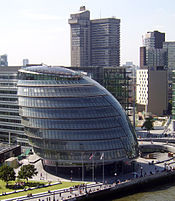- London Assembly
-
London Assembly Type Type Unicameral Leadership Chair Jennette Arnold AM, Labour Members 25 assembly members Conservatives 11 / 25Labour 8 / 25Liberal Democrats 3 / 25Greens 2 / 25Independent 1 / 25Elections Voting system Additional Member System Last election 1 May 2008 Meeting place 
City Hall
Southwark, Greater London
United KingdomWebsite www.london.gov.uk London
This article is part of the series:
Politics and government of
LondonGovernanceFunctional bodiesLondon in the UKLondon in the EUSubdivisions
The London Assembly is an elected body, part of the Greater London Authority, that scrutinises the activities of the Mayor of London and has the power, with a two-thirds majority, to amend the mayor's annual budget. The assembly was established in 2000 and is headquartered at City Hall on the south bank of the River Thames, close to Tower Bridge. The assembly is also able to investigate other issues of importance to Londoners (transport, environmental matters, etc.), publish its findings and recommendations, and make proposals to the mayor.
Contents
Assembly members
The London Assembly comprises 25 members elected using the additional member system of proportional representation. Elections take place every four years - at the same time as for the Mayor. There are 14 constituencies each electing one member, with a further 11 members elected from a party list to make the total members from each party proportional to the votes cast for that party across the whole of London. Parties must win at least 5% of the party list vote in order to win any seats. Members of the Assembly have the postnomial title 'AM'. The annual salary for a London Assembly member is approximately £54,000.[1] The current chair of the London Assembly is Dee Doocey. In 2009/10 the chair of the London Assembly was Darren Johnson.
Since its creation in 2000, nine Assembly members have subsequently been elected to the House of Commons: David Lammy, Meg Hillier and Diana Johnson for Labour; Andrew Pelling, Bob Neill, Angie Bray, Bob Blackman and Eric Ollerenshaw for the Conservatives; and Lynne Featherstone for the Liberal Democrats. In addition, Val Shawcross, Assembly Member for Lambeth and Southwark was selected, but unsuccessful, as the Labour parliamentary candidate for the constituency of Bermondsey and Old Southwark. Richard Tracey is so far the only example of a former MP later being elected to the Assembly.
Structure of the assembly
Political party Assembly members Current members 2000 2004 2008 Conservative 9 9 11 Labour 9 7 8 Liberal Democrat 4 5 3 Green 3 2 2 British National Party 0 0 1 [2] United Kingdom Independence Party 0 2 [3] 0 - ^ http://legacy.london.gov.uk/assembly/london_assembly_members.jsp
- ^ The BNP member subsequently became an independent in August 2010.
- ^ The UKIP members subsequently defected to Veritas and then formed the One London party.
Constituency members
Further information: London Assembly constituenciesLondon Assembly constituencies 
London-wide members
Party Members Conservative Andrew Boff, Victoria Borwick, Gareth Bacon Liberal Democrats Michael Tuffrey, Dee Doocey, Caroline Pidgeon Labour Nicky Gavron, Murad Qureshi Green Jenny Jones, Darren Johnson Independent (elected as BNP candidate) Richard Barnbrook See also
External links
- London Assembly
- London Assembly publications
- London Assembly Liberal Democrats
- London Assembly Labour
Governance of Greater London Regional London boroughs - Barking and Dagenham
- Barnet
- Bexley
- Brent
- Bromley
- Camden
- Croydon
- Ealing
- Enfield
- Greenwich
- Hackney
- Hammersmith and Fulham
- Haringey
- Harrow
- Havering
- Hillingdon
- Hounslow
- Islington
- Kensington and Chelsea
- Kingston upon Thames
- Lambeth
- Lewisham
- Merton
- Newham
- Redbridge
- Richmond upon Thames
- Southwark
- Sutton
- Tower Hamlets
- Waltham Forest
- Wandsworth
- Westminster
Ceremonial Historical - Metropolitan Board of Works (MBW) 1855–1889
- London County Council (LCC) 1889–1965
- Greater London Council (GLC) 1965–1986
- Leaders
Regional planning in England Regions Regional development agencies East • East Midlands • London • North East • North West • South East • South West • West Midlands • Yorkshire and the HumberLocal authority leaders' boards East • East Midlands • North East • North West • South East • South West • West Midlands • Yorkshire and the HumberDefunct regional assemblies London Local enterprise partnerships Local enterprise partnership
Wikimedia Foundation. 2010.

